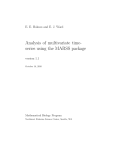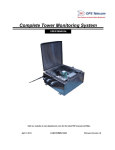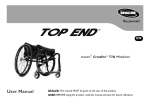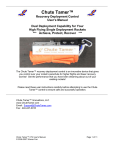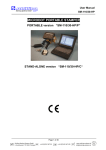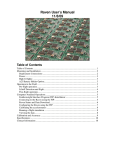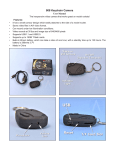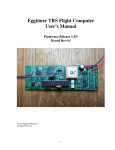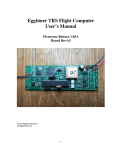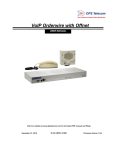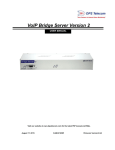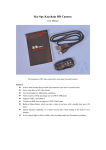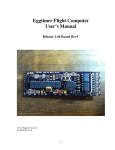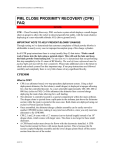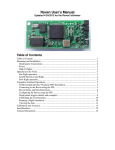Download Issue #362 - Apogee Components
Transcript
In This Issue What Do You Need For Dual Deployment? Cover Photo: The Aerotech Strong Arm rocket kit being readied for launch. Get your own at: http://www.apogeerockets.com/Rocket_Kits/Skill_Level_3_Kits/Strong_Arm Apogee Components, Inc. — Your Source For Rocket Supplies That Will Take You To The “Peak-of-Flight” 3355 Fillmore Ridge Heights Colorado Springs, Colorado 80907-9024 USA www.ApogeeRockets.com e-mail: [email protected] Phone: 719-535-9335 Fax: 719-534-9050 ISSUE 362 APRIL 8, 2014 What Do You Need For Dual Deployment? By Tim Van Milligan A common question that we get at Apogee Components is: “What do I need to get started in dual-deployment?” It is such a common question, that we revised the home page of our web site to point people to the answer. I also thought I’d write about it here in this article, so interested people have more information to make informed choices. To start, it is necessary to give an overview of what dual-deployment is. And this is simple: dual-deployment is a method of limiting the walking distance you have to do in order to retrieve your rocket after a flight. It is mainly used for high power rockets or those that fly extremely high (greater than 3000 feet). But I’m seeing a trend that people want to use the technology in smaller rockets too. I can’t think of a single person that absolutely loves chasing their rockets a long way, and it doesn’t matter what size they are. Right? The heart of the dual-deployment rocket is the electronics and multiple recovery devices. The electronics controls when the two recovery devices are deployed in the flight. The first one is always deployed near apogee of the trajectory, because this is the slowest point in the flight of the rocket. The advantage of this is that the aerodynamic forces trying to tear the rocket apart are lowest when the speed of the rocket is the slowest. The first recovery device is small, like a tiny parachute or a streamer. You can even use “drogueless” recovery as explained in Peak of Flight Newsletter #361 (www.ApogeeRockets.com/Education/Downloads/Newsletter361.pdf). The purpose of the small recovery device is that the rocket descends quickly, so that it doesn’t drift very far in the wind. flight. Rocket kit If you’re just starting out in high power rocket or using dual-deployment recovery, I highly recommend starting out with a rocket kit. The advantage of a kit over scratch building is that you get a rocket of proven stability. You will have enough to worry about with the dual-deployment items, so why worry about the rocket itself being stable and structurally sound? In theory, every rocket could be used for dual-deployment. But once you consider what is needed for success, you’ll probably come to the conclusion that it is easier to start with a rocket kit that was specifically set up for dual deployment. The most important criteria is that the rocket needs some location to house the electronics. In the industry, we call this the “electronics bay” or “Ebay” for short. It is also sometimes called the avionics bay (Av-bay for short). Unfortunately, the terminology can sometimes cause confusion for people new to dual-deployment rockets. The term “payload bay” sounds very similar to “electronics bay,” but it is subtly different. A “payload” can be almost anything carried in the rocket, like an egg, a stuffed animal, or a lander device. Sometimes a payload could be “electronics,” but it doesn’t have to be. On the other hand, an electronics bay is much more specific in what goes inside. So if you see a rocket kit that has a “payload bay,” it doesn’t necessarily mean that it can be used as an ebay. Not without some modification, of course. But the good news is that you can turn a payload bay into an electronics bay. The main parachute is always deployed later, when the rocket is closer to the ground. The chute is sized to slow the rocket to a speed where it won’t be damaged on contact with the ground. Since it is deployed from the rocket at a low altitude, in theory, the rocket won’t have time to drift very far, even if it is breezy. What kind of rocket kit should you consider for use as a dual-deployment rocket? If it is not already set up as a “dual-deployment kit,” (http://www.apogeerockets.com/ Rocket_Kits/Dual_Deployment) then I recommend something large in diameter, and with a long payload bay. These are the easiest to work with. That is the way dual-deployment is supposed to work. So what do you need to accomplish this? This article will give you a list of items to consider. Not all of them are absolutely required, but they do help assure a successful A list of payload capable rockets is listed on our web site at: http://www.apogeerockets.com/Rocket_Kits/Payload-Capable_Rockets. Again, not all of these are easily About this Newsletter Newsletter Staff You can subscribe to receive this e-zine FREE at the Apogee Components web site (www.ApogeeRockets.com), or by sending an e-mail to: [email protected] with “SUBSCRIBE” as the subject line of the message. Page 2 Continued on page 3 ISSUE 362 Writer: Tim Van Milligan Layout / Cover Artist: Tim Van Milligan Proofreader: Michelle Mason APRIL 8, 2014 Continued from page 2 What Do You Need For Dual Deployment? convertible into dual-deployment rockets, but it is a good place to start. The reason I suggest a large diameter rocket is that it gives you a lot of internal volume to house the electronics. In other words, big rockets are more forgiving of where and how you mount the electronics. You can, for example, make huge mistakes on mounting the electronics, and then remount them correctly without having to buy additional items. And having a large diameter rocket means you can stick your hands inside the rocket to hook up connectors and move wiring around easily. If you’re just starting out in dual-deployment, I’d highly recommend starting with a 4 inch diameter rocket for this reason alone. Additionally, there is also a lot more room for your recovery devices, which helps reliability in ejecting them out of the rocket (they don’t have to be packed so tight). While 4 inch diameter rockets are more expensive, and require larger rocket engines, you’ll find that the frustration factor is greatly reduced and you’ll get your rocket into the air a lot quicker. an Ebay for the electronics. A payload bay is just an empty tube that can carry something inside. It can be modified though. Typically, adding an Ebay into a payload bay is easy, but it has to be accomplished during the construction of the rocket kit. Why? Because you’ll Figure 1: The typical Ebay kit contains the mounting board be leaving out some of for the altimeter. the components. The Ebay contains its own bulkheads on the ends, so you won’t need the one on the payload bay. You can simply leave the aft bulkhead off and just use the tube of the payload bay. Does modifying a payload rocket into a dual-deployment rocket change the stability of the rocket? You bet. But the good news is that it ALWAYS makes the rocket longer and therefore more stable. This is a good thing. So don’t worry about if the kit is going to be unstable if you modify it to have an Ebay up front. It will be more stable after you make the modification. That gets us to the next item that you’ll need... Ebay If the rocket kit you select doesn’t come with one, you will need to order or make an Ebay to hold all of your electronics. All of the Ebays that we sell currently at Apogee Components (www.ApogeeRockets.com/Electronics_Payloads/ Electronic_Bays) are specifically designed to hold the electronics for a dual-deployment rocket. If it says “Ebay,” you can assume that the product contains a mounting board for the altimeter and the necessary hardware to secure that board into the rocket. What size Ebay will you need to order for your rocket? That’s easy. They are classified by tube diameter. So if your rocket is 4 inches in diameter, get an Ebay that fits into that 4 inch tube. Electronic Altimeter You will need a dual-deployment altimeter. Here is where your options are more complex. At Apogee Components, we offer several different manufacturers (www.ApogeeRockets.com/Electronics_Payloads/ If the rocket comes with a payload bay, you’ll still need Continued on page 4 • Eliminates Shear Forces on Centering Rings • Mates with AeroPacks Flanged Engine Retainers • Fits Standard HPR Tubes, Blue Tubes, and Fiberglass Tubes • Made from Aircraft Grade Aluminum www.ApogeeRockets.com ISSUE 362 APRIL 8, 2014 www.ApogeeRockets.com Experienced HPR Builders Use Thrust Plates Page 3 Continued from page 3 What Do You Need For Dual Deployment? from for a bare-bones dual-deployment system. The question we often get is: “Which one should you pick?” To be honest, here at Apogee Components, we like all the altimeter systems. If they didn’t work well, we wouldn’t carry them in our store. The real question you might have then, is why do we carry so many that have nearly identical capability? And that is easy for me to answer. At Apogee, we sell a lot of altimeters, and that causes an availability issue. We sell them so fast that we run out of stock sooner than we anticipated. If we are out of stock, then our customers have no choices at all and have to put their projects on hold or buy from someone else. Figure 2: The Altimeter mounted in the E-bay Dual-Deployment). So selecting one can be confusing for first-time buyers. Some dual-deployment altimeters have extra sensors which means they have more “bells and whistles” and extra capability. If you are just looking for the bare-bones dual-deployment system, you can filter out these high-end systems. In fact, I recommend that to first-time dual-deployment customers. Not only does it save costs, but it reduces the complexity of the system, thereby making it easier to set up for flight. Those high-end altimeters have a purpose, but you don’t need to get the top-end system for your first flight. And don’t worry about having multiple systems in your inventory of electronics; you’ll need it later. When you work your way up to a Level-3 size rocket, you are required to have redundant electronics in your rocket, and they can’t be of the same type. So you’ll can use your bare-bones altimeter that you get initially as the back-up system when you eventually fly the L-3 rocket. But that still leaves several manufacturers to choose Also, since the hobby is fairly small, our suppliers are not set up to run high volume production runs. We can easily clean them out of inventory that they themselves have, and we often do. This causes supply disruptions of a particular dual-deployment altimeter. Therefore, we carry products from several manufacturers, so that we’re reasonably confident that we’ll have something good for a customer when they want to get started in dual deployment. So which one should you pick? My answer is ask your friends for their advice, or flip a coin. If you call me and ask me which one you should buy, I’m not going to bad-mouth any of the manufacturers that we carry. Like I said, if they were junk, I wouldn’t have them in our store. The one additional criteria that you can use to select the altimeter is how it interfaces to your personal computer. That is where they differ slightly. Some connect directly via a USB cord, and some require special cables or interface device. Check our web site, and better yet, download the users manuals for each of the altimeters to see which one is more comfortable for you to work with. Battery Continued on page 5 Rocket Jewelry • The Perfect Launch-Range Accessory • Subtle, Tasteful, Fashionable & Distinctive • Makes A Great Gift for Family and Friends • Display Your Passion for Rocketry www.ApogeeRockets.com Page 4 ISSUE 362 APRIL 8, 2014 Continued from page 4 What Do You Need For Dual Deployment? First of all, some altimeters come with a battery, but most of them don’t. The battery, which powers the altimeter and ignites the ejection charges, is not normally included with the altimeter. Almost all of them will use a 9 Volt battery, but the trend among flyers is towards LiPo batteries Figure 3: LiPo battery. for their lower weight and higher energy densities. If you’re trying to use a small diameter rocket (under 2.6 inches in diameter), you’ll probably opt for the smaller LiPo battery because room in the rocket is always needed. If you go with a rechargeable LiPo battery, remember that you’ll also need to get the battery charger that goes with it. Mounting Hardware Even though the Ebay has a mounting board (typically called the “sled”) for the electronics, it doesn’t contain the actual pieces-parts to mount the printed-circuit board to the sled. ApogeeRockets.com/ Electronics_Payloads/ Electronics_Accessories/ Electronics_Mounting_Kit) which contains all the little items you’ll need to mount the components of the dual-deployment system into the rocket. Figure 4: Electronics MountThe advantage of our kit is ing Hardware kit the convenience of getting everything in one place. You can also find the items individually if you want to save a little money. Here are the items in the kit so you can see what types of things you’ll need for your rocket: 4-40 Nylon standoffs – used to hold your circuit board off of the sled board of your electronics bay. We recommend nylon because is can shear apart should the rocket crash. The shearing action reduces the energy that is transferred to the expensive electronics. Many people have told us that by using nylon instead of steel standoffs, they were able to salvage the expensive part of the rocket (the electronics). At Apogee, we have a “Mounting Hardware Kit” (www. Continued on page 6 Pratt Hobbies GO BOX Launch Controller Launch controller for mid-power rockets. Hooks right up to your car’s battery. No more dead AA batteries! Plenty of electricity to set off any type of rocket motor igniter. 24 foot cord, allows you to stand far back for launch safety. Audible continuity buzzer lets you know the circuit is armed and ready for launch. Flat-jaw alligator clips Brought to you by: (for easy hook-up of igniter.) www.ApogeeRockets.com/Launch_Accessories/Launch_ Controllers/Go_Box_Launch_Controller ISSUE 362 APRIL 8, 2014 Page 5 Continued from page 5 What Do You Need For Dual Deployment? 4-40 X 3/16 Nylon screws – used to secure your electronics circuit board to the nylon standoffs. 4-40 Nylon nuts – can be used on the bottom of the nylon standoffs if you have a thin sled board that doesn’t have enough thickness to make threads using the tap. #43 Drill Bit – To drill the holes in your ebay sled for the mounting hardware. 4-40 3-flute plug tap – To put threads in the holes in the ebay sled so you can screw in the nylon standoffs for the circuit board. 1/2 inch CPVC pipe cap – These are used to hold the ejection charge powder, (a type of ejection charge canisters). These heavy-duty holders do not need to be replaced after each flight as they are reusable. 2-56 X 3/4 inch Fillister head screw – These hold the ejection charge caps down against the two bulkheads on the electronics bay. 2-Circuit barrier strip – These allow you to quickly hook up your igniters for the ejection charges to the outside ends of the bulkheads. In other words, you won’t have to hook up the igniter wires directly to the electronics. You hook the wires up to the barrier strip instead. This saves you time when you are preparing your rocket for flight. 4-40 X 1 inch binding head screws – These screws hold down the barrier strips to the bulkheads, so they don’t pop off during flight. 4-40 Nuts – The nuts are tightened down on the back side of the bulkheads that hold the barrier strips 22ga stranded wire in two colors (5 feet of each color) – This is probably all the extra hook-up wire you’ll need to connect your electronics to the ejection charge wells on the two bulkheads. 4-pin 3M female crimp connector , 4-pin 3M male crimp connector – Used to make a quick-disconnect on one end of the electronics bay. This allows you to remove just one bulkhead from your Ebay if you want to take things apart to inspect the electronics just prior to flight. Otherwise, you’ll need extra-long wires that dangle around inside of the e-bay; which could whip around during flight and snag the electronics or battery. Closed cell foam (sheet) – This allows you to wrap up your battery and to provide any other protective foam inside the electronics bay. This is more of a requirement for LiPo batteries that don’t have the hard case that a regular 9V battery does. Zip ties – These are handy for securing to the sled board all the wires leading to the ejection charges, the battery, and the on/off switch. They can be strung together to make longer wire ties for larger items in the Ebay. Battery Connector We sell a 9V battery connector so that it is easy to quickly install the battery to power up the altimeter (www. ApogeeRockets.com/index.php?main_page=product_supplies_info&cPath=52_159&products_id=1284). If you are using a LiPo battery, you’ll either need a different connector, or you’ll wire the battery directly to the altimeter (which is more common with LiPo batteries) Power Switch The purpose of the power switch is to conveniently turn off/on the altimeter in the rocket. If you don’t have a power switch, then you’d have to physically disconnect the battery from the altimeter. In rocketry, we discourage simple “flip switches” or “slide switch” because they can accidentally be Continued on page 7 • Allows you to use smaller diameter motors in your rocket kits (adds versatility) • Change out motors in seconds • Works with all single-use and reloadable motors • Four sizes available www.ApogeeRockets.com Page 6 ISSUE 362 APRIL 8, 2014 www.ApogeeRockets.com Quick-Change Motor Adapters Continued from page 6 What Do You Need For Dual Deployment? turned on by brushing against them during normal handling. Also, as the rocket takes off, the jarring of the rocket can cause the switch to change position (turning off the electronics). If you do use those types of switches, make sure they are mounted sideways so that they can’t be switched on/off by the rocket taking off. At Apogee Components, we sell three different types of power switches: Push Switch – This is a simple and inexpensive on/ off switch for your electronics. This is the one that comes with our electronics mounting hardware kit. The switch is typically mounted completely inside of the rocket, and it is activated by pushing a dowel through a hole in the side of the rocket to to reach the switch. See: www.ApogeeRockets.com/ Electronics_Payloads/Electronics_Accessories/ Simple_Switch Rotary Switch – For people that like to have the switch on the outside of the rocket, this switch lets them use a screw driver as a key to turn the switch into the on/off positions. See www.ApogeeRockets. com/index.php?main_page=product_supplies_ info&cPath=52_159&products_id=71 Push-Hold Switch – For the most streamlined rocket, this special switch allows you to have just metal contacts (terminals) on the outside of the rocket. To turn the electronics on/ off, you can just use a piece of metal to short across the terminals. To make sure Figure 5: The rotary that it isn’t accidental- switch ly turned on/off, such as bumping the rocket against the metal launch rail, the contacts must be shorted for a minimum of 5 seconds. It is just like holding down a momentary push switch for a duration of 5 seconds to turn on/ off the electronics. See: www.ApogeeRockets. com/index.php?main_page=product_supplies_ info&cPath=52_159&products_id=1379 Ejection canisters The ejection canisters hold the black powder that is ignited to create the gas pressure that pushed out the parachutes. As mentioned previously, the ones that come in our mounting hardware kit are fixed in the rocket (on the bulkheads of the Ebay). But we also sell other canisters that are disposable but can be moved around inside the rocket prior to launch. The nice thing about these canisters, and why Continued on page 8 • Designed to ignite the top motor in two-stage rockets. • Provides an easy way to stage composite propellant motors • Fires off igniters after a preprogrammed amount of time following liftoff • G-switch senses liftoff and insures against a false launchdetection • Small, lightweight design is great for skinny rockets • Easy-to-use, and will fire off any igniter, including clusters! www.ApogeeRockets.com Battery, battery connector, mounting board and igniter are not incuded. ISSUE 362 APRIL 8, 2014 www.ApogeeRockets.com Staging Electronics Page 7 Continued from page 7 What Do You Need For Dual Deployment? they are so popular, is that they have the igniter built into them. That is one less component that you have to worry about. www.ApogeeRockets. com/Ejection_Systems/ Ejection_Canisters Igniters Other igniters might be used in dual deployment. But in all honesty, you’ll need to read the user’s manual of the altimeter and see which ones the manufacturer recommends. Like I mentioned, it will also depend on which type of battery you use. Black powder It is the black powder that actually pushes out the parachute. When it ignites and burns, it produces a tremendous amount of gas that pressurizes the inside of the rocket and causes it to slide apart. Figure 6: Ejection canister with igniter The igniter is used to set off your ejection charges. The igniter you use will be dependent on the altimeter and the battery that you select. The best igniters are e-matches. But e-matches are regulated by the federal government, and require an explosives permit to purchase. They are the best, because they require very little electrical current to burst into flame and ignite the black powder in the ejection canister. You will need black powder. Unfortunately, it is also classified as an explosive by the government. Apogee Components does not sell it for this reason. The good news is that you can purchase it locally from a gun store that also sells muzzle-loading supplies. If you are old enough (over 21) in the United States, you can purchase up to 1 pound of black powder without an explosives permit. That is enough for around 200 flights, because you don’t need very much per flight. The next best igniter is the Quest Q2G2 (www.ApogeeRockets.com/Rocket_Motors/Quest_Accessories/ Quest_Q2G2_Igniter_6pk). It also requires very little current. Unfortunately, at the time of this writing (April 2014), they are out of stock by the manufacturer. When we have information on their availability, we’ll post something on our web site. You do NOT need to contact us and ask us if we have more information. Until we post something on our web site, we don’t have any additional information. You can call Quest and ask them if you want to talk to someone. Apogee, in my opinion, is the most up-front rocketry vendor on the internet, because we update our web site every day with whatever information we have. We are not holding anything back – if the information you seek is not on our web site, that means we don’t have the information. Parachutes Typically, the rocket kit you purchase will come with one parachute. It is always the “main” chute that will slow the rocket for the landing. But the trend we’ve been seeing from manufacturers is to leave the parachute out of the kit. The reason is that it can save the customer money. Check the Apogee Components web site to verify if the kit you want contains a parachute. Drogue Parachute Other than the few “dual-deployment” kits on the Apogee Components web site, the drogue chute is not included and must be purchased separately. See Peak-of-Flight Newsletter #361 (www.ApogeeRockets.com/Education/ Continued on page 9 • Unique ‘transforming’ rocket - looks like a normal rocket, but then rotor blades pop out at ejection • Competition efficiency: high flights and long descent time • Features curved rotor blades and free-spinning hub, just like those used in international competitions • Versatile: can use any 18mm diameter motor • Comes with video instructions for error-free assembly Page 8 ISSUE 362 APRIL 8, 2014 www.ApogeeRockets.com Gyro Chaser Helicopter Rocket Continued from page 8 What Do You Need For Dual Deployment? Downloads/Newsletter361.pdf) for information on selecting the right size drogue chute for your rocket. Optional Supplies When people call us, they often ask for a “complete list of everything they might need.” It is hard to say if the following items are needed, but I can tell you that they make dual-deployment easier to accomplish. Motor Retainer The motor has to be restrained during the flight, prevented from moving either forward into the rocket, or being expelled rearward when the ejection charge goes off. Most high power kits do not come with a retainer. They must be purchased separately. Choosing the correct one will depend on which motor tube you have. The motor retainers are sized Figure 7: Motor Retainer for a specific size tube. So when you order your kit, be sure to pay attention to the diameter of the engine mount tube, and the manufacturer that makes the tube. Once you have that information, go to the Apogee web site and first look at the diameter of the retainers. This will get you into a category of two or three retainers. Next, match the specific manufacturer of the tube to the retainer. On the Apogee web site (www.ApogeeRockets.com/ Building_Supplies/Motor_Retainers_Hooks), we list which manufacturer’s tubes the retainer will fit onto. Removable Rivets Dual-deployment rockets are designed to come apart in sections. But during flight, the rocket has to stay together. This is where removable rivets come in handy. Instead of using heavy screws and nuts to hold the sections of the rocket together, we have small Figure 8: Removable plastic rivets that do the same rivets thing but are easier to use. The are a two part system that can be reused because they are easily removable. www.ApogeeRockets.com/Building_Supplies/Misc._Hardware/Removable_Plastic_Rivets Shear pins Shear pins are different from the rivets. The shear pins are used to temporarily hold the rocket together until the ejection charge goes off. They simply break in half when the ejection charge goes off, allowing the rocket to separate and deploy the main parachute. What they really do, is to prevent premature separation of the rocket parts until the ejection charge goes off. Premature separation can occur because of the pressure difference of the air on the inside of the rocket compared to the atmospheric pressure. On the ground, the internal pressure and the external pressure are the Figure 9: Nylon same. But as the rocket ascends Shear pins skyward, the atmospheric pressure decreases with altitude. That means that the pressure inside is greater than the outside air, and there is a net force trying to pop open the rocket. With just a friction fit of the parts (such as a coupler fitContinued on page 10 We’re Paying Cash For Great Articles for This Newsletter Are you a writer looking for some serious pocket change? We’re paying up to $350 for good how-to articles for this newsletter. If you’re interested, see our submission guidelines on the Apogee web site. www.ApogeeRockets.com/Newsletter/Newsletter_Guidelines ISSUE 362 APRIL 8, 2014 Page 9 Continued from page 9 What Do You Need For Dual Deployment? Nomex® Shock Cord Protector ting into a body tube), the sections of the rocket can slide apart too easily. The shear pins prevent this. The larger the diameter of the rocket, or the higher it goes, the greater the force. My rule of thumb is that shear pins should be used on rockets that are greater than 4 inches in diameter. www. ApogeeRockets.com/Building_Supplies/Misc._Hardware/ Nylon_Shear_Pins_20_pack If you are using a shock cord that is not flame resistant (like Nylon strap), then you might want to consider a shock cord protector. It insulates the shock cord from the heat of the ejection charge. If you are using a Kevlar® shock cord, you do not need a shock cord protector. You’ll find shock cord protectors at: www.ApogeeRockets.com/Building_ Supplies/Parachutes_Recovery_Equipment/Shock_Cord_ Protectors 2-56 Tap and Drill Set If you do use our shear pins, then this tap-and-drill set will allow you to make the right size holes in the rocket parts. Note that this tap-and-drill set is included in our Mounting Hardware Kit. But if you want to get it separately, see: www.ApogeeRockets.com/Building_Supplies/ Tools/2-56_Tap_and_Drill_Set Parachute Protector This is the reusable alternative to recovery wadding. It is placed in the rocket between the ejection charge and the parachute, and is attached to the shock cord so that it stays with the rocket and can be reused. We have several sizes available on our web site at: www.ApogeeRockets. com/Building_Supplies/Parachutes_Recovery_Equipment/ Reusable_Wadding The size you choose will depend on the diameter of the rocket kit. Parachute Swivels It is rare that a descending rocket does not sway and spin as it descents. To prevent the suspension lines on the parachute from winding up, a parachute swivel is used. We have Figure 10: Parachute several sizes on our web Swivels site that can be added depending on the weight of the rocket. www.ApogeeRockets.com/Building_Supplies/ Parachutes_Recovery_Equipment/Swivels Deployment Bags Continued on page 11 Roam In Our Forest of Over 190 Different Types • Unique and exotic kits from over 20 different manufacturers • Skill Levels range from “easy” to “fiendish” • Sizes from 1/4A motor to level-2-high-power • We build & fly them to find out what they’re like, saving you grief • More new ones arriving all the time • Educational bulk packs available too Continued on page 10 www.ApogeeRockets.com/Rockets_By_Manufacturers Page 10 ISSUE 362 APRIL 8, 2014 www.ApogeeRockets.com Looking For A Fun Rocket Kit? Continued from page 10 What Do You Need For Dual Deployment? Tender Descender Deployment bags are used on large diameter parachutes to assure they open slowly and in an orderly fashion. More information can be found on our web site at: www.ApogeeRockets.com/Building_Supplies/Parachutes_ Recovery_Equipment/Parachute_Deployment_Bags Quick Links Large parachutes are harder to attach to rockets because it is harder to pass the rocket body through the loops on the suspension lines. This is were quick links come in handy. They are like a link of a chain that can be opened by unscrewing a little nut on it. Then it is fastened to the parachute and the shock cord Figure 11: Quick links. so they are fastened together. It makes it easy to move the parachute from one kit to another. More information at: www.ApogeeRockets. com/Building_Supplies/Parachutes_Recovery_Equipment/ Quick_Links This is a tether-release device that allows you to turn an ordinary high power rocket kit into a dual-deployment rocket. It basically allows you to put both parachutes into the same compartment in the rocket, instead of separate chute bays that is typical of a dual-deployment rocket. This makes the set-up of a Tender Descender is a little more complex, and therefore you should probably perform a traditional dual-deployment rocket before this. Get more info at: www.ApogeeRockets.com/Electronics_Payloads/ Tender_Descender Rail Buttons Most of the large kits come with rail buttons, but you’ll want to verify this by looking at the kit page on the Apogee Components web site. Rail buttons replace launch lugs and allow the rockets to be used on longer and stiffer launch rails (instead of rods). www.ApogeeRockets.com/Building_ Supplies/Launch_Lugs_Rail_Buttons/Rail_Buttons Epoxy Used for rocket construction and making fin fillets to improve the durability of the rocket. We have a couple of different types of epoxy. For more information, see: www. Continued on page 12 • Won’t Shatter Like Brittle Phenolic Tubes! • Super Smooth Surface With Tight Spirals • Standard LOC Diameters Up To 6 inches • Cut and Slot With Standard Tools • No Fiberglass Wrap Needed • Sands and Paints Easily • Cheaper than Fiberglass Blue Tube From Always Ready Rocketry www.ApogeeRockets.com High Power Tubes & Couplers www.ApogeeRockets.com/Building_Supplies/Body_Tubes/Blue_Tubes ISSUE 362 APRIL 8, 2014 Page 11 Continued from page 11 What Do You Need For Dual Deployment? ApogeeRockets.com/Building_Supplies/Adhesives Additional resources: Modern High Power Rocketry 2 – great reference for high power rocketry. It also covers the subject of dual-deployment as well as other topics like clustering and staging. See: www.ApogeeRockets.com/Rocket_Books_Videos/ Books/Modern_High_Power_Rocketry_2 Videos – Are you looking for a step-by-step process of building a dual-deployment kit? On our web site, we have instructions for the Level 2 rocket kit. The videos are free to watch on YouTube, and you can find them at: www. ApogeeRockets.com/Advanced_Construction_Videos/All The videos start with video #101, and run through video # 122. You’ll see most of the products mentioned here in this article, and how to specifically use them and set up a dualdeployment rocket. About The Author: Tim Van Milligan (a.k.a. “Mr. Rocket”) is a real rocket scientist who likes helping out other rocketeers. Before he started writing articles and books about rocketry, he worked on the Delta II rocket that launched satellites into orbit. He has a B.S. in Aeronautical Engineering from Embry-Riddle Aeronautical University in Daytona Beach, Florida, and has worked toward a M.S. in Space Technology from the Florida Institute of Technology in Melbourne, Florida. Currently, he is the owner of Apogee Components (http://www. apogeerockets.com) and the curator of the rocketry education web site: http://www.apogeerockets.com/education/. He is also the author of the books: “Model Rocket Design and Construction,” “69 Simple Science Fair Projects with Model Rockets: Aeronautics” and publisher of a FREE ezine newsletter about model rockets. See also: Peak-of-Flight Newsletter #324 which covers frequently asked questions about dual deployment (www. ApogeeRockets.com/Education/Downloads/Newsletter324. pdf). Join The NAR.org Mention Apogee Components Wanted: Your Rocket Products If you’re a manufacturer of rocketry products, like kits, electronic payloads, parts, construction tools, motors, launch equipment, or something totally cool, we’re interested in talking to you. We’re always looking for new products to sell. So why have Apogee sell your products? We have the best customers that are looking for something new. We provide the product support for the customers, so you don’t have to. We take care of all of the hassles, so you can focus on what you do best. We are a volume seller - Our web traffic means buyers will find you easier. Our endorsement means you sell more and make more money! www.ApogeeRockets.com If you’re not getting enough sales, let’s talk. • Transforming rocket - changes from balistic trajectory to a gliding aircraft by sliding the wing forward • Efficient elliptcal and polyhedral wing shape • The wing also changes its angle-of-attack • For competition, or just for fun! • Uses 1/2A to A motors Page 12 ISSUE 362 APRIL 8, 2014 www.ApogeeRockets.com Cirrus Breeze Rocket Glider












